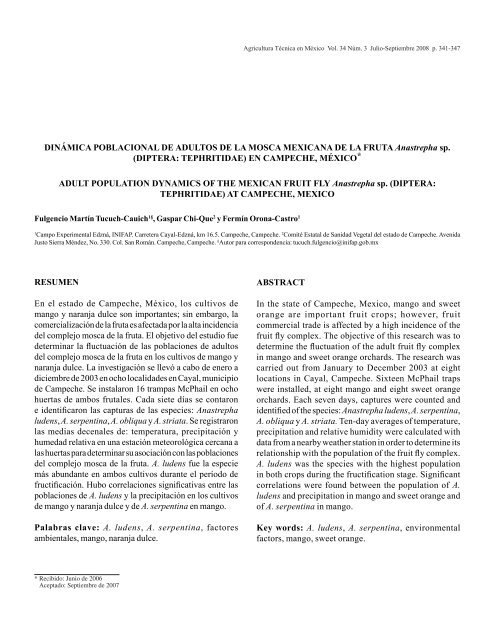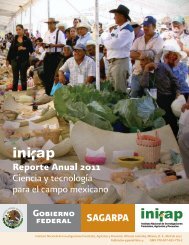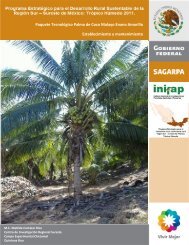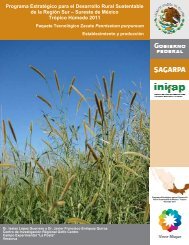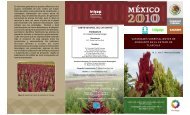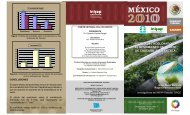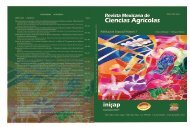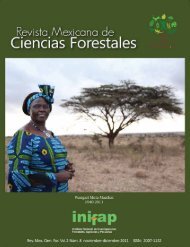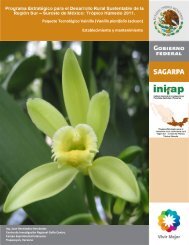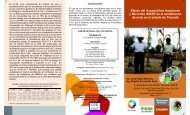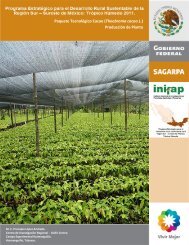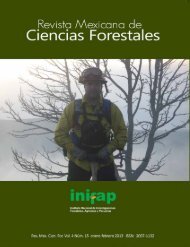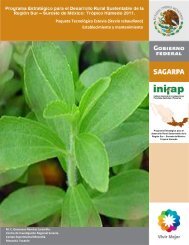Vol. 34 Núm. 3 - Instituto Nacional de Investigaciones Forestales ...
Vol. 34 Núm. 3 - Instituto Nacional de Investigaciones Forestales ...
Vol. 34 Núm. 3 - Instituto Nacional de Investigaciones Forestales ...
Create successful ePaper yourself
Turn your PDF publications into a flip-book with our unique Google optimized e-Paper software.
Agricultura Técnica en México <strong>Vol</strong>. <strong>34</strong> Núm. 3 Julio-Septiembre 2008 p. <strong>34</strong>1-<strong>34</strong>7DINÁMICA POBLACIONAL DE ADULTOS DE LA MOSCA MEXICANA DE LA FRUTA Anastrepha sp.(DIPTERA: TEPHRITIDAE) EN CAMPECHE, MÉXICO *ADULT POPULATION DYNAMICS OF THE MEXICAN FRUIT FLY Anastrepha sp. (DIPTERA:TEPHRITIDAE) AT CAMPECHE, MEXICOFulgencio Martín Tucuch-Cauich 1§ , Gaspar Chi-Que 2 y Fermín Orona-Castro 11Campo Experimental Edzná, INIFAP. Carretera Cayal-Edzná, km 16.5. Campeche, Campeche. 2 Comité Estatal <strong>de</strong> Sanidad Vegetal <strong>de</strong>l estado <strong>de</strong> Campeche. AvenidaJusto Sierra Mén<strong>de</strong>z, No. 330. Col. San Román. Campeche, Campeche. § Autor para correspon<strong>de</strong>ncia: tucuch.fulgencio@inifap.gob.mxRESUMENEn el estado <strong>de</strong> Campeche, México, los cultivos <strong>de</strong>mango y naranja dulce son importantes; sin embargo, lacomercialización <strong>de</strong> la fruta es afectada por la alta inci<strong>de</strong>ncia<strong>de</strong>l complejo mosca <strong>de</strong> la fruta. El objetivo <strong>de</strong>l estudio fue<strong>de</strong>terminar la fluctuación <strong>de</strong> las poblaciones <strong>de</strong> adultos<strong>de</strong>l complejo mosca <strong>de</strong> la fruta en los cultivos <strong>de</strong> mango ynaranja dulce. La investigación se llevó a cabo <strong>de</strong> enero adiciembre <strong>de</strong> 2003 en ocho localida<strong>de</strong>s en Cayal, municipio<strong>de</strong> Campeche. Se instalaron 16 trampas McPhail en ochohuertas <strong>de</strong> ambos frutales. Cada siete días se contarone i<strong>de</strong>ntificaron las capturas <strong>de</strong> las especies: Anastrephalu<strong>de</strong>ns, A. serpentina, A. obliqua y A. striata. Se registraronlas medias <strong>de</strong>cenales <strong>de</strong>: temperatura, precipitación yhumedad relativa en una estación meteorológica cercana alas huertas para <strong>de</strong>terminar su asociación con las poblaciones<strong>de</strong>l complejo mosca <strong>de</strong> la fruta. A. lu<strong>de</strong>ns fue la especiemás abundante en ambos cultivos durante el período <strong>de</strong>fructificación. Hubo correlaciones significativas entre laspoblaciones <strong>de</strong> A. lu<strong>de</strong>ns y la precipitación en los cultivos<strong>de</strong> mango y naranja dulce y <strong>de</strong> A. serpentina en mango.Palabras clave: A. lu<strong>de</strong>ns, A. serpentina, factoresambientales, mango, naranja dulce.ABSTRACTIn the state of Campeche, Mexico, mango and sweetorange are important fruit crops; however, fruitcommercial tra<strong>de</strong> is affected by a high inci<strong>de</strong>nce of thefruit fly complex. The objective of this research was to<strong>de</strong>termine the fluctuation of the adult fruit fly complexin mango and sweet orange orchards. The research wascarried out from January to December 2003 at eightlocations in Cayal, Campeche. Sixteen McPhail trapswere installed, at eight mango and eight sweet orangeorchards. Each seven days, captures were counted andi<strong>de</strong>ntified of the species: Anastrepha lu<strong>de</strong>ns, A. serpentina,A. obliqua y A. striata. Ten-day averages of temperature,precipitation and relative humidity were calculated withdata from a nearby weather station in or<strong>de</strong>r to <strong>de</strong>termine itsrelationship with the population of the fruit fly complex.A. lu<strong>de</strong>ns was the species with the highest populationin both crops during the fructification stage. Significantcorrelations were found between the population of A.lu<strong>de</strong>ns and precipitation in mango and sweet orange andof A. serpentina in mango.Key words: A. lu<strong>de</strong>ns, A. serpentina, environmentalfactors, mango, sweet orange.* Recibido: Junio <strong>de</strong> 2006Aceptado: Septiembre <strong>de</strong> 2007


